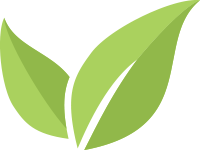Homeopathy for Plants, don’t Treat the Pest!
- News
-
Jul 14
- Share post

Nothing is more exciting for a gardener than to see the rewards of their labor bring forth food to nourish them and their family; yet nothing is more disappointing than all their work succumbing to pests, diseases, or environmental catastrophes.
The spring of 2014 found me on our 60-plus acre organic farm, happily ordering seeds, installing the PVC watering system, and planning my newly expanded 4,000-plus-square-foot garden down to the last square foot. But in June my hopes were dashed as seemingly overnight, grasshoppers had descended upon my blossoming garden, devouring everything in sight. One particular plant, a Costata Romanesco zucchini, had just flowered, but by the next day the grasshoppers had eaten everything on the plant, leaving only a short stem.
Lack of rainfall had afflicted Texas for several years, but summer 2014 was par- ticularly brutal. Drought or dry conditions are perfect for the egg pods of locusts and grasshoppers to explode, and gardeners, farmers, and ranchers have battled these plagues for ages. Swarms have been known to devour entire fields in a short amount of time. That summer, I was bombarded by grasshoppers every time I went outside.
Agrohomeopathy – What to do?
I knew I had to act fast if I was going to save my garden! I consulted the internet for options but quickly discounted them as being too impractical for my large garden, too late in the season to apply, or too slow to take effect. Being a homeopathy enthusiast, I turned to one of only two books published in English on the subject of agrohomeopathy (the science
of applying homeopathic remedies on plants)—Homeopathy for Farm and Garden by V.D. Kaviraj. Unfortunately, I did not find grasshoppers as a pest rubric in the repertory. However, I did see that Helix tosta, a homeopathic remedy made from snails, was used to deter snails and slugs in the garden, and that Bombyx processionea, a homeopathic remedy made from the processional caterpillar, was used to deter caterpillars. So I did the only thing I could think of…I decided to make a remedy from the grasshoppers.
Homeopathic manufacturers carefully follow the guidelines set forth in the Homeopathic Pharmacopoeia of the United States (HPUS). They make remedies in an FDA approved manufacturing facility with strict quality control measures. They take great care to make sure there are no contaminants and test each batch for purity. This is extremely important for the health and safety of people who ingest homeopathic remedies. For agrohomeopathy
use, however, remedies can often be made right in your own kitchen.
I called my three young boys, armed them with pint mason jars and lids, and told them to go collect all sizes, shapes, and colors of grasshoppers from the fence posts. Since I wasn’t sure which grasshoppers were eating my plants, I figured I would cover all my bases with a wide variety. I combined all the grasshoppers into one pint jar, added 1⁄2 cup of vodka and 1⁄4 cup of water, and set it on the shelf in a dark corner. Soaking raw organic matter (e.g., herbs or, in this case, grasshoppers) in an alcohol solution draws out the healing substances, and the resulting liquid becomes a tincture – the starting place for making a homeopathic remedy. All you need is time and a dark, undisturbed place to keep your container.
Normally, you would let the bottle sit for several weeks before using the resulting tincture, but time was short, as every day the grasshoppers were attacking more plants in my garden. So after waiting three agonizingly long days, I took the tincture and made a very crude 6c homeopathic remedy. (See diagram opposite.)
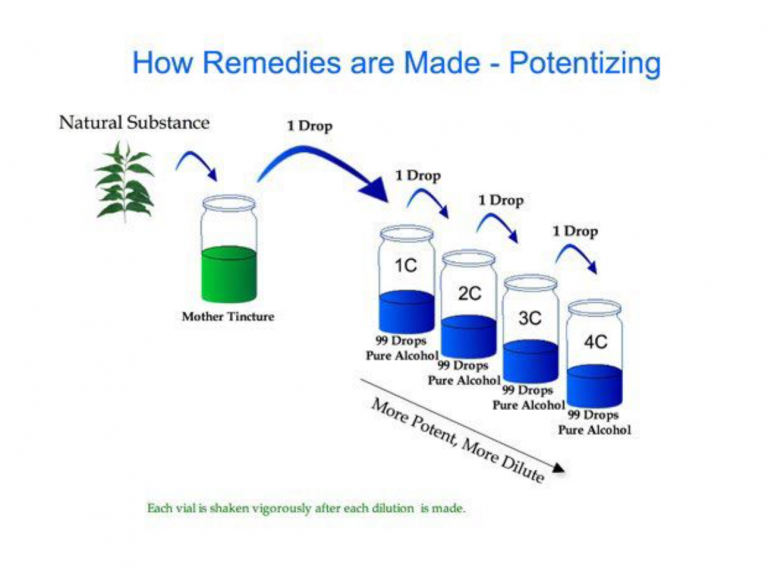
Giving remedies to plants is not much different than giving remedies to people, once you understand that you can think of a plant as similar to an upside-down human. The plant’s roots take in nutrients and moisture, much like our mouth. The plant’s leaves act somewhat like our skin. While a plant can absorb remedies through its leaves (similar to how we can absorb remedies through our skin), I always prefer to put a remedy in water and thoroughly water the plant’s roots, if accessible. In this instance, the zucchini didn’t have any leaves left to mist, so watering the roots with my homemade Grasshopper 6c remedy was my only option. I also watered the rest of the zucchini plants with the remedy, giving them a prophylactic dose. Just as Hahnemann treated healthy people with a genus epidemicus remedy when scarlet fever threatened a community, the same principle can be applied to plants. If there is a threat of a pest or a disease in the area, you can treat the healthy plants with a prophylactic dose of a remedy.
I love how the correct homeopathic remedy works so effectively and quickly. By the very next day, the grasshoppers were nowhere to be seen on any of the plants watered with the Grasshopper remedy, though grasshoppers were still plentiful everywhere else in the garden and on the farm. Seeing how I was on to something beneficial to the plants, I proceeded to water the rest of the plants in the garden with the remedy.
Selecting a homeopathic potency is sometimes harder than selecting the rem- edy. Since I (and my garden) had gotten some initial respite from the pests, I sat down with Kaviraj’s book again to study
it in more depth and discovered that he recommends starting with a 6X potency. So going back to my tincture, I remade the grasshopper remedy in a 6X potency. Ten days after the initial watering, I watered the zucchini plants again with the new 6X potency.
Two weeks later, I again gave the plants in my garden the Grasshopper 6X remedy. One month later in August, I excitedly harvested the first zucchini from that Costata Romanesco plant. It had grown back to its original size and was producing a healthy harvest. Meanwhile, the other zucchini plants that had been prophylactically watered were left untouched by the grasshoppers and were producing a bountiful harvest as well.
The grasshoppers remained plentiful on the farm that summer and did not bother any more plants in my garden. The grasshoppers were not poisoned with chemicals, so they were left in their organic state in the food chain, making for some very happy pastured chickens.
This experience so profoundly solidified my belief in using homeopathic remedies on plants that homeopathy is the only method I use in my gardens. I firmly believe that homeopathy for our plants, and even our soils, holds a big answer for much of our chemically-laden, toxic world.
Agrohomeopathy – think differently
We have become so accustomed to thinking we have to kill the pest or the disease! After all, this is how most of us were trained to think growing up in our Western allopathic culture. Down with the disease that causes all the problems! Stomp out the virus! Exterminate the pest!
What if we’re looking at this all wrong? What if we applied our “homeopathic mindset” to our plant world? What if we strengthened the plant’s immune system so that the pests or diseases didn’t even want to attack that plant?
Let’s first look at some of the reasons pests and diseases attack plants:
• Monocropping: Planting massive quantities of the same plant in large areas is the norm in modern agribusiness. In nature, it is unnatural to plant large areas with the same crop. Nature sees it as an “excess” and something that needs to be eliminated. It does this by allowing pests or disease to come in and wipe out the excess.
• NPKfertilizers: Chemicalfertilizers containing nitrogen (N), phosphorus (P), and potassium (K) are what we’ve been offered from the chemical companies to treat plant and soil imbalances. But does this really work? Do plants only need three chemicals for healthy growth?Are they able to absorb the man-made synthetic chemicals? What about all the other nutrients that plants need?
• Genetically modified organisms (GMOs): Introduced to strengthen the plant, genetic modification to organisms has failed miserably by creating super weeds. Glysophate herbicides such as Monsanto’s Roundup have been in use for nearly a quarter of a century on the premise that when genetically modified seeds (“Roundup Ready seeds”) are planted, the farmer can spray Roundup on his fields to kill other weeds and not harm the crop. This has not only created weeds that are resistant to Roundup, but we have been left with contaminated soil and drinking water while the human health dangers are surfacing rapidly.
• Microbiome of the plant has been ignored: Plants do not live in a test tube but are influenced by their surroundings – other plants, the soil, air, light, weather, nutrients, microbes, and flora and fauna. Plants provide things for each other in the form of nutrients, shade, or physical support. They are each other’s “best friends.” Companion plants were designed to be together – to attract beneficial insects and pollinators, deter unwanted pests, and offer shelter and food for other critters.
When we ignore these critical components, we succumb to allopathic thinking.
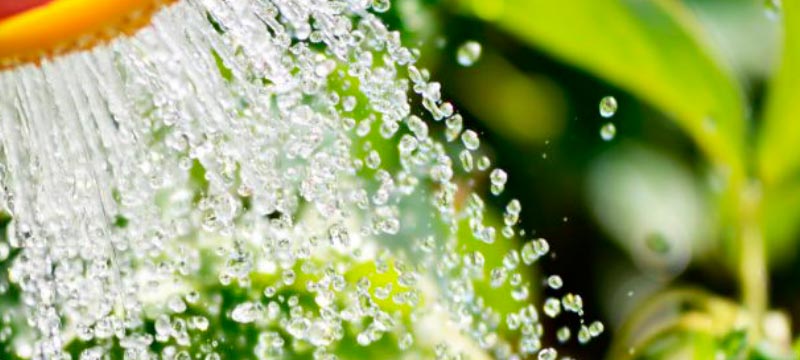
Giving Remedies to Plants. HERE’S HOW TO DO IT
Giving remedies to plants is easy. Dissolve a few pellets of the remedy in a pint or quart bottle that is two-thirds full of water. Shake vigorously. This is your remedy solution. Then pour the contents (or a portion of the contents depending on how many doses you need to apply) into your larger watering can (or cans). Fill the can with a powerful jet of water (such as a garden hose); if an agitating jet of water is not available, fill the can with water and stir vigorously with a wooden stick.
Now you’re ready to water. While a plant can absorb remedies through its leaves, I always prefer to target the plant’s roots, if accessible. Water enough to thoroughly saturate the roots, but don’t drown them. Water proportionately—a small plant won’t need as much as a tree or large shrub. When watering, take into account the diameter reach of the roots, and water all of that ground above.
Important Final Step: Record your remedy, potency, and date, as well as the plant’s symptoms and why you chose that remedy. I use a spiral-bound notebook and record notes for each plant on a new sheet of paper. I find it helpful to also record any secondary remedies that I considered, as this can shorten my repertorization time if I need to move on to another remedy. As always in homeopathic treatment, if the symptoms change, retake the case.
Advantages of agrohomeopathy
To help us understand this concept, let’s step back and look at what happens when people are treated the same as the plants above. When people are fed “artificial” medicines and foods, we become unhealthy, we succumb to diseases, and we become obese (including our offspring). The same thing happens to plants when fed “artificial” fertilizers and chemicals. They become unhealthy, they succumb to diseases and pests, and they become “obese” (the plant and their fruit). Just as we cannot be healthy in this state, the plant and its fruit (offspring) can’t be healthy either.
Turn the tables and look at what happens when people are given homeopathic medicines and good nutrition – we become healthy, have resistance to disease, have a strong vitality, maintain a healthy weight, and have healthy offspring. Plants follow the same order – when they are given homeopathic medicines and good nutrition (chemicals in their natural state and healthy soil), they have resistance to disease, a strong vitality, a healthy weight (size), and healthy produce (offspring).
The advantages of growing healthier plants that produce healthier food (with zero chemical inputs, residuals, and toxicity) have profound implications, not only for mankind but also for all creatures and our entire planet.
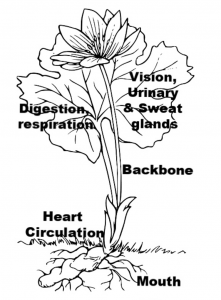
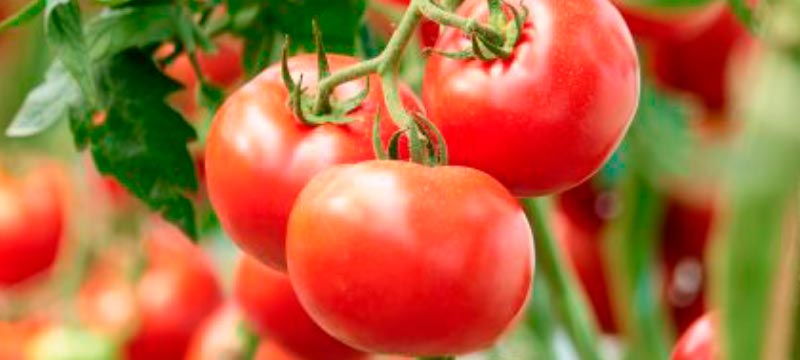
Terrific Tomatoes. A TRIED-AND-TESTED RECIPE
If you want terrific tomatoes, the following homeopathic remedies can help. They serve as a fertilizer, improve the harvest and taste, act like a tonic, promote healthy growth, and help prevent blossom-end rot as well as greenback (caused by potassium deficiency).
Right after the last spring frost, water all tomato seedlings once with Calendula 30c. (I use 6 to 8 globules dissolved in 30 liters of water; you might use less water depending on how many seedlings you have.) Calendula has a revitalizing effect, is antibacterial, and strengthens the plant. It is also helpful if plant roots were torn off during repotting.
One week later, apply the following three-day treatment:
- Day 1: Calcarea carb 6X
- Day 2: Kali phos 6X
- Day 3: Magnesium phos 6X
After one week, apply the remedies again, and then once more a week later, for a total of three applications.
Source: Homeopathy for Plants by Christiane Maute, 4th edition, pages 130-131.
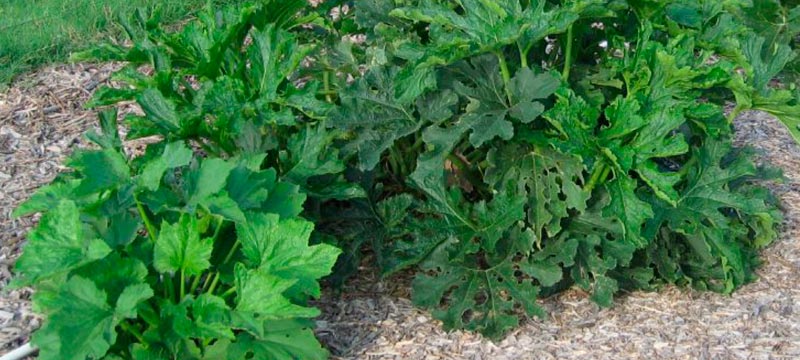
A thriving Costata Romanesco zucchini plant (at left), after the author treated it with a homeopathically prepared remedy
Do plants possess consciousness?
The dictionary defines consciousness as an “awareness by the mind of itself and the world.” Humans and animals certainly have a consciousness. Can the same be said of plants?
Radko Tichavsky, a leading agrohomeopath, researcher, author, and director of the Comenius Institute in Latin America, has done some incredible research on plants. Based on those studies, he has made the following observations.
1. Plants are aware of themselves
“Many researchers assume that due to the absence of a brain, plants have no intelligence and are not aware of themselves. Actually, most of the higher plants recognize their own roots and are able to distinguish between the root systems of other plants. Therefore, they meet one of the conditions of intelligence: awareness of themselves.”
2. Plants make decisions
“In addition, plants make daily deci- sions; where to direct the roots in search of nutrients and where to tilt their leaves and branches in search of greater sunlight or moisture.”
3. Plants make sacrifices
“Green plants do make decisions. For example, when they are attacked by aphids, depending on the area of damage, they may decide to sacrifice a branch, a leaf, or other non-vital part by removing nutrients and re-directing them into new outbreaks with a greater chance of survival.”
4. Plants have memory
Plants show similar reactions to the conditioned reflexes that Ivan Petrovich Pavlov discovered in dogs. Tichavsky’s studies show that plants not only feel pain, but a response is elicited even when the torturer comes near. Through the use of an EKG machine, Tichavsky observed the electrical responses of the Dracaena sp. plant when pricked by a mechanical pin. The plant was mechanically “pricked” three times. Each time, the prick elicited an electrical response that was greater than the time before. After this, the plant responded electrically even when the “torturer” was one meter away and then again at 20 centimeters away.
“In other words, higher plants meet the profile required to be considered living entities. Plants make decisions, have individual awareness of themselves, can develop conditioned reflexes and have memory. Therefore they can be considered intelligent entities that develop during their lifetime, individual profiles.”
The bottom line
Homeopathy works on all living things, as Samuel Hahnemann wrote in The Organon, aphorism 32: “Every true medicine works at all times, under all circumstances, on every living being and arouses in him its peculiar symptoms.”
In Homeopathy for Farm and Garden, 2012, 4th Ed, page 59, V.D. Kaviraj says: “In reality, it is the plant that suffers from the pest or disease, therefore, it is the plant that needs treatment.”
What remedies help plants?
Since plants respond to homeopathic remedies, the next task is to figure out what remedies they need. Do they respond to the same remedies people do? This can be a bit tricky, as the answer is both yes and no. Plants do respond to some of the same remedies as people, particularly in acute and first-aid situations.
Here are some homeopathic remedies frequently used in the treatment of people that are also useful in the treatment of plants:
Aconitum. Sudden symptoms, such as the plant wilting and drying out; symptoms come on after a cold, dry, north wind, sud- den storm, or hot days and cold nights.
Arnica. First-aid remedy for trauma, pests, pruning, transplants, mechanical injury (such as dropping a pot and bruising the roots), and bleeding from wounds.
Calendula. Open or ulcerating wounds from pruning or lacerations. Suitable for all cases where the skin or bark is broken, with tears and abrasions.
Cantharis. When plants and flowers appear burnt, especially after misting in the sun. Sunburn and blisters on leaves and petals.
Carbo veg. This remedy can rescue plants from a near-death state, such as plants that appear to be dying or recover- ing very slowly after being transplanted or after loss of vital fluids.
Phosphorus. This remedy can help plants damaged by lightning.
Silicea. One dose of Silicea usually helps to generate the seeds and give them a healthy start. This remedy strengthens all plants. Only dose once, however, as too much can cause irreversible symptoms.
Staphysagria. Helpful for the conse- quences of pruning and lacerations on plants.
When dealing with a plant pest, pathogen, or disease, the homeopathic remedies needed by plants will tend to be different than the ones commonly used for people, because people don’t suffer from these problems. The study of companion plants (mentioned earlier) can provide valuable information to point to a useful remedy. Companion plants support each other when physically grown together, but they also strengthen and improve the host plant when given in homeopathic dosing (similar to how a constitutional remedy can help a person).
Tomatoes and Ocimum
basilicum (basil)
In a 2012 research study, two Lithuanian tomato cultivars, Balčiai and Vytėnų Didieji, were dosed with varying poten- cies of the homeopathic preparation of basil, Ocimum basilicum. Potencies of D6 (6X), 30c, 200c, and 1M were given to the tomatoes six times every 10 days. The result was outstanding. All potencies increased the beta-carotene content of Balčiai tomatoes. The 30c, 200c, and 1M potencies increased the contents of beta-carotene and lycopene in the Vytėnų Didieji tomatoes.
Agrohomeopathy as a Remedy from Grasshoppers.
HOW I MADE A 6X REMEDY AT HOME

You can try making a remedy from any pest or diseased part of your plant’s roots. It may work to help the plant fend off the pest or disease, as it did in my garden.
This method of remedy-making will work well for raw substances that are fully or partially dissolvable in an alcohol-water solution. Collect your raw material in a clean glass jar, in my case this was grasshoppers! Employ your children, grandchildren, next door neighbors in this endeavor! I used 1⁄2 cup vodka (any grain-based alcohol will work as a preservative) and 1⁄4 cup water. You may enlarge these proportions as needed, keeping the ratios the same or even increasing the alcohol portion if you wish. Label and cover with a tight-fitting lid, then set aside in a cool, dark, undisturbed place.
After several days to a few weeks, using a dropper, take out 1 drop from this tincture and add it and 9 drops of water to another clean glass container—any amber bottle or small mason jar will do, as long as it is clean and free of odors. Succuss this 10 or more times; that is, close the container tightly and hit the bottom on the open side of your palm or against a soft padded book 10 or more times. (I chose to succuss it 40 times.) Label this as 1X. Using a clean dropper, remove 1 drop from this 1X solution, and put that drop in another clean glass container along with 9 drops of water. Succuss this 10 or more times, and label this as 2X. Continue this process until you reach the potency just below your desired potency. (In my case, this would be 5X because my desired potency was 6X.)
Then take 1 drop from this 5X potency, add to 9 drops of grain alcohol, and succuss. This is your final 6X potency to dose with. At this step, the alcohol is added as a preservative, with the presumption that you will want to save this final 6X potency. Be sure to label it with date, potency, and remedy name. (If you plan to use the remedy quickly and do not plan to save it, you don’t need to add alcohol and can make the final potency with water.)
Note: An X potency is also known as a Decimal potency, because the ratio of tincture to water or alcohol is 1 part to 9 parts. If you want to make a C potency (i.e., Centesimal potency), the ratio of tincture to water or alcohol is 1 part to 99 parts, so you could use 1 drop of tincture to 99 drops of water/alcohol instead.
Making a larger quantity: Whether you’re making an X potency or a C potency, you can always adjust the quantity, as long as you keep the proper ratio. For example, when making my X potency, I could have used 10 drops of tincture and 90 drops of alcohol or water, because the ratio is still 1 part to 9 parts. This would have resulted in 5 milliliters of liquid remedy. In fact, you probably will want to adjust the quantities and make at least 5 milliliters of a remedy, because when applying remedies in liquid form to plants, agrohomeopathy expert V.D. Kaviraj advises adding 5 to 10 milliliters of remedy to 10 liters of water.
Natural Weed Herbicides.
Spring is when weeds start germinating in unwanted areas of our lawn, garden, or farm acreage. We can be tempted to resort to harmful chemicals. This spring, why not try your hand at a more natural alternative?
There are several homeopathic remedies to choose from. The following is a condensed list taken from V.D. Kaviraj’s Homeopathy for Farm and Garden; more thorough reading of this resource is highly recommended before selecting a remedy. It is advised to do a small test sample before applying to your entire lawn or large acreage.
When using remedies as weed inhibitors, it is recommended to double dose in short succession, such as evening and morning after, to achieve satisfactory results.
Athyrium filix femina (Lady Fern). Will be effective as a weed remover since it inhibits seed germination.
Foeniculum sativum (Fennel). Contains a substance in the roots that prevents other plants from growing there. Caution: only use this where you do NOT want other plants growing immediately afterwards.
Silicea (Silicea terra). Has the capacity to set up premature flowering, so this may prevent the seed formation in weeds.
Tingis cardui (Spear Thistle Lace Bug). Some lace bugs are useful in the control of weeds. This bug lives off thistles, so when prepared homeopathically, it will be more effective than the living insect.
Vaccinium myrtillus (Bilberry). This is a fungus that inhibits subalpine spruce trees, so in homeopathic potency, it has a use as a general weed remedy.
Law of Similars
The outcome of that research collaborates what V.D. Kaviraj discovered in his 12-year study in Australia. The Law of Similars is applicable throughout nature—like produces like, like cures like, and like attracts like in every respect. Like also imitates like, and like also neutralizes like. When this is applied to plants, it means that what grows naturally together in nature will work harmoniously in potency. This principle also applies to all natural predators, as well as pheromones, allelopathy, allelopathic chemicals, fungi, and bacteria. (Allelo means “of each other” and pathy means “to suffer,” so allelopathy refers to the chemical inhibition of one plant species by another. Allelopathic chemicals are produced by the plant and can influence the growth and development of another plant, either positively or negatively.) Nature has given us an accurate model for pest and disease control without the disadvantages of resistance, pollution, and added poisons or disease.
Do plants have constitutional types?
While the Law of Similars model of dosing greatly simplifies the discovery of the correct remedy in plants, there is another method to apply as well. V.D. Kaviraj discovered that you can classify plants into constitutional types according to their botanical groupings. For example, cucumbers, squash, zucchini, watermelons, and gourds all belong to the Cucurbitaceae family. Plants in this family all suffer from the same pests and diseases, so the same remedy will work across all the plant genus members. He suggests that Thuja is a remedy that can be used to deter borers that attack plants in the Cucurbitaceae family.
The time is ripe for a better solution
The world is already contemplating life without glyphosate. Farmers are looking for viable alternatives. Australia and parts of the United States are addressing the problem of herbicide-resistant weeds by form- ing regional groups comprised of farmers,
municipal officials, and chemical retailers. Wouldn’t it turn the world on its heels if these groups were to discover agrohomeopathy instead?
Amidst the increasing pesticide contamination of our food and water, along with the increasingly destitute condition of our soil, the time is ripe for a viable solution to our use and abuse of conventional pesticides and fertilizers. Homeopathy—an age-old solution applied in a fresh way—is a realistic alternative not only for large-scale farms but also for the backyard gardener.
Recommended Resources
• Homeopathy for Farm and Garden: The Homeopathic Treatment of Plants by Vaikunthanath Das Kaviraj, 2012, Narayana Publishers, 4th edition
• Homeopathy for Plants: A Practical Guide for House, Balcony and Garden plants by Christiane Maute, Narayana Publishers, 4th edition
• Gardening and Farming with Homeopathy Facebook Group: www.facebook.com/groups/ GardeningwithHomeopathy/
• Turning Ranch Homeopathics—the author’s business; a U.S. supplier of homeopathic books, single remedies and kits for people, plants, and animals, and other educational resources. www.TRHomeopathic.us
Footnotes
- https://www.nytimes.com/2003/01/14/business/widely-used- crop-herbicide-is-losing-weed-resistance.html
- https://www.soilassociation.org/media/7202/ glyphosate-and-soil-health-full-report.pdf
- https://www.businessinsider.com/glyphosate-cancer- dangers-roundup-epa-2019-5
- http://www.comenius.edu.mx/AgrohomeopaticBiotypesOK.pdf 5.
- https://www.ishs.org/ishs-article/952_104
- https://www.producer.com/2020/01/agriculture- contemplates-life-without-glyphosate/?fbclid= IwAR34AE7y-vgHNhII7wyPwLTnNqEfughZ0AUZSnJ8Q 0LzZP7EkfXw3xRFEZs

About the Author
Sherri Maines has been involved in homeopathy for over a decade. She is self-taught and continues to study under homeopathic leaders. Sherri started using homeopathy exclusively at Turning Ranch, her family’s self-sufficient homestead, successfully treating their animals, plants, and family. She shares her knowledge and passion in her Facebook group, Gardening and Farming with Homeopathy. A sought-after writer and speaker, she has written articles for Homeopathy Today and spoken at homeopathic conferences. Sherri and her husband Ted work alongside world leaders in their on-line homeopathy business, TRHomeopathic.us.
To access all issues of Homeopathy Today & articles like this one join NCH!” here is the link to join: https://www.homeopathycenter.org/join
